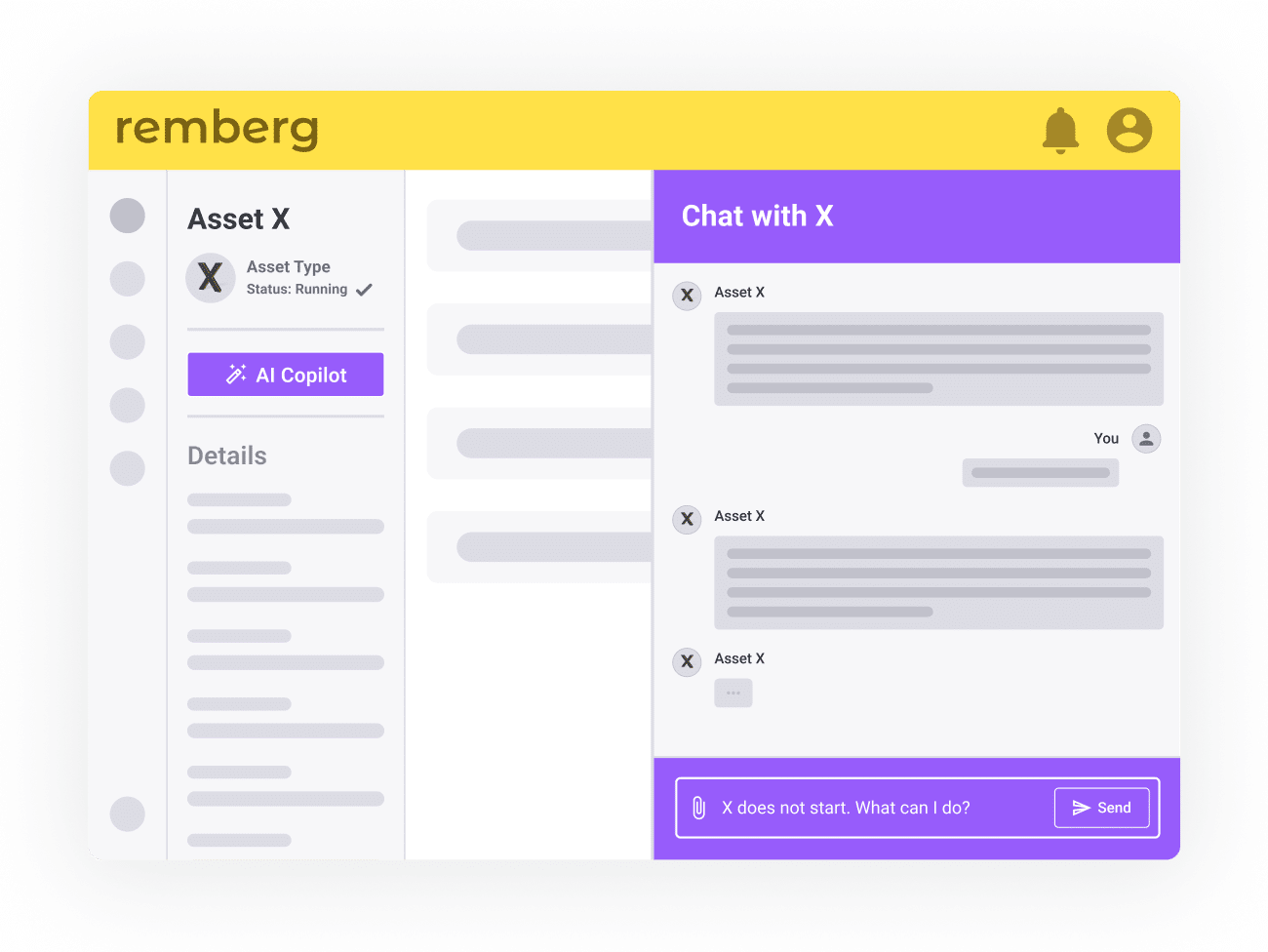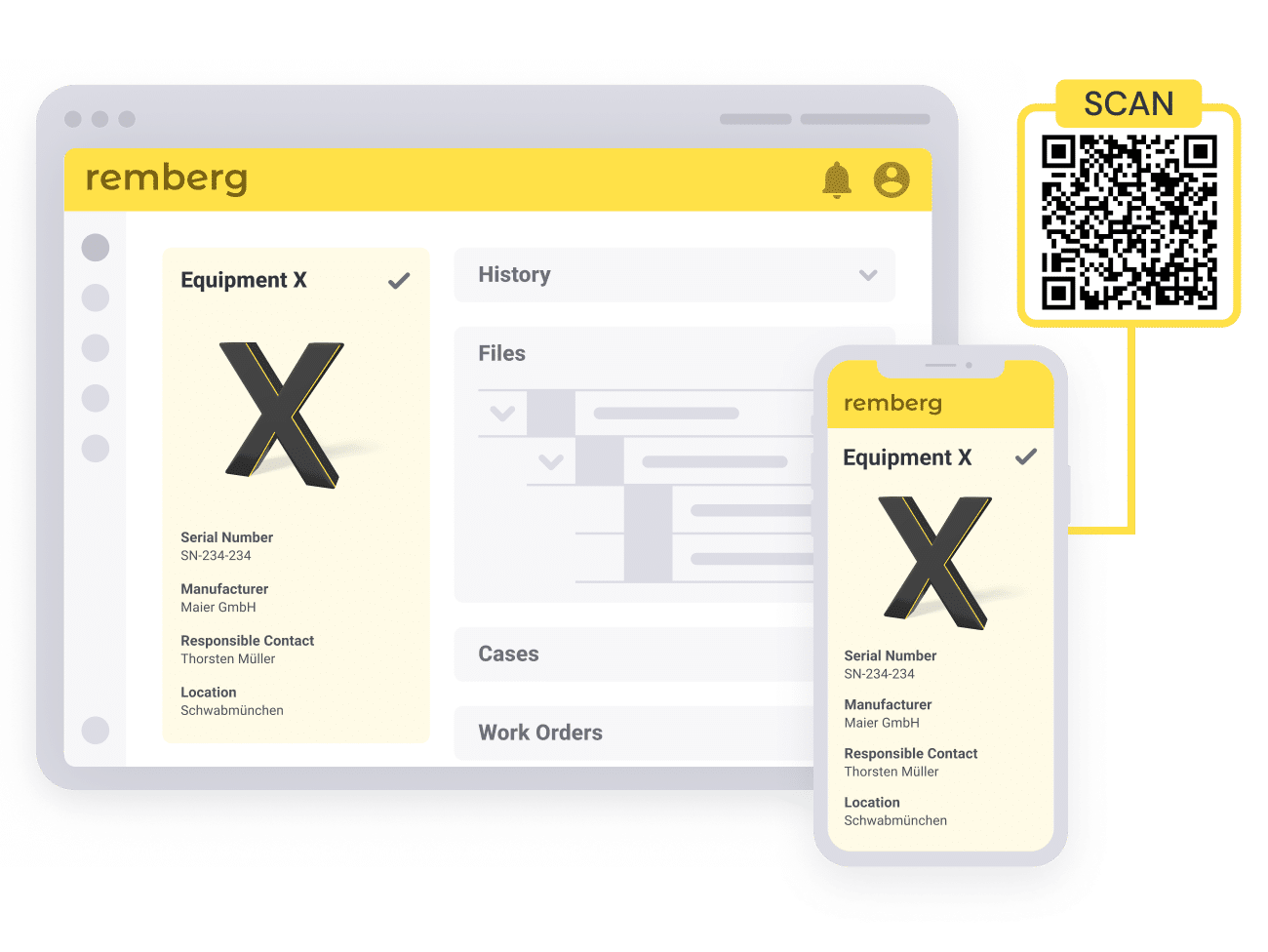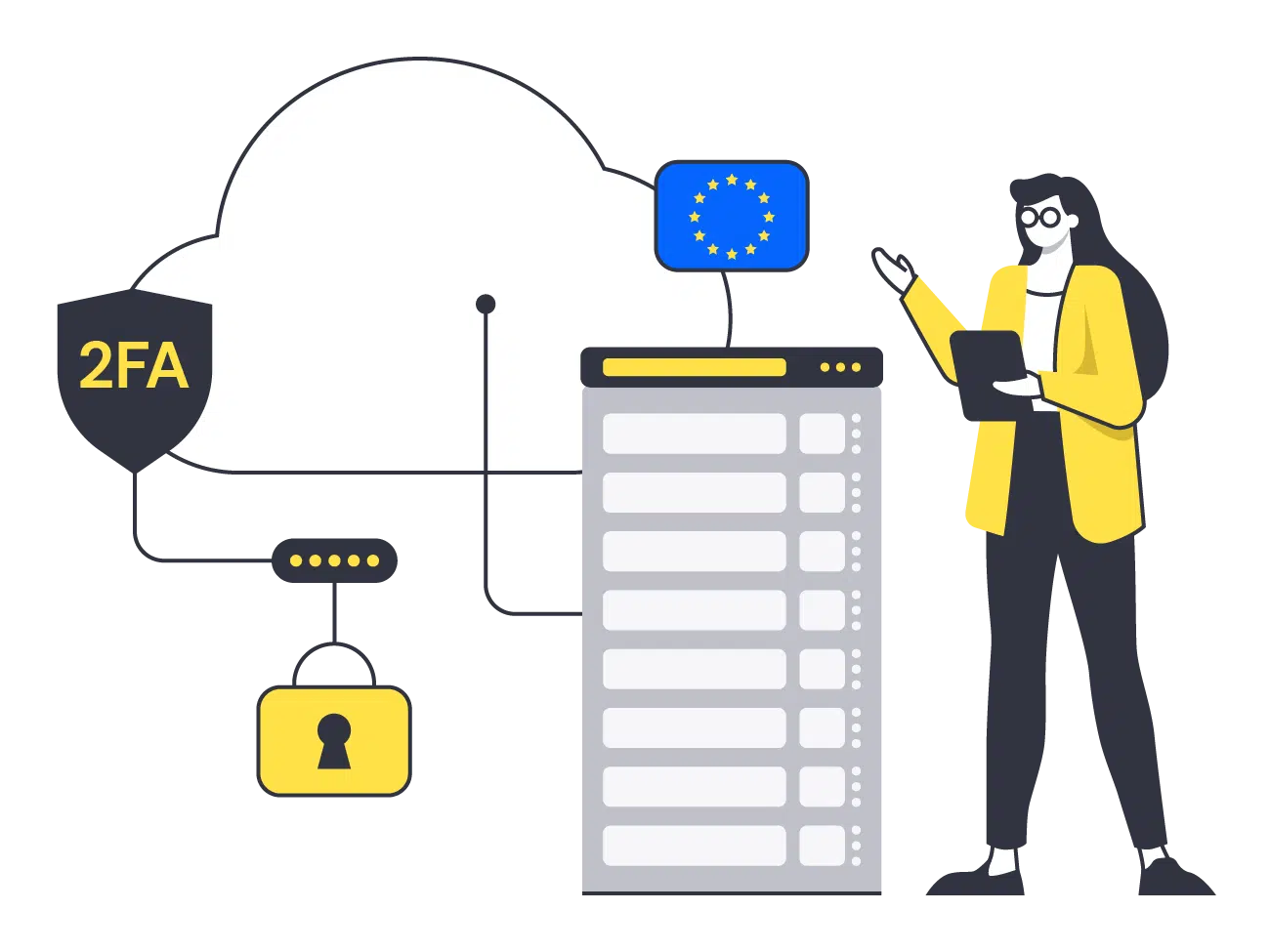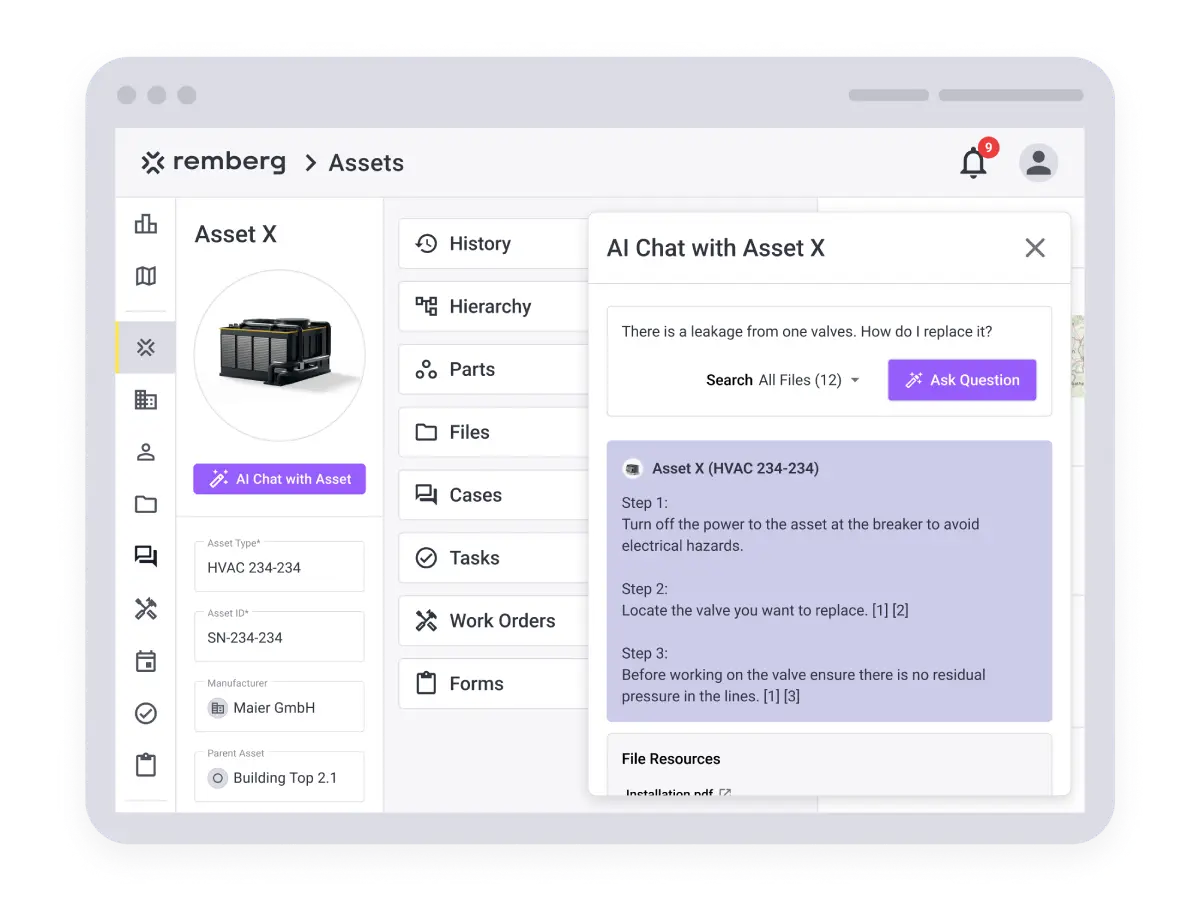Our customers





The problem
You're expected to do more with less. The number of work orders is increasing, but resources and budget are shrinking.

Before
- Overloaded: Increasing work orders but limited resources result in inefficient processes and team frustration
- Outdated: Old legacy systems and manual workflows prevent quick responses to issues, leading to costly repairs
- Intransparent: Missing information complicates planning and increases downtime

After
- Easy: Digital processes and quick access enables you to handle more work orders
- Modern: Intelligent software allows for proactive maintenance and faster responses to issues
- Transparent: All information in one place – better planning, less downtime, and reduced costs
Record every incident and manage work orders
With remberg, all incidents are recorded in one place. You can prioritise them, assign them and transfer them directly to work orders. This means your team knows immediately what needs to be done – without any paperwork or email chaos. And thanks to QR codes and the mobile app, this can also be done directly on site.


Resolve issues faster with the AI copilot
When issues arise, ask technical questions directly to the AI Copilot and receive instant answers from relevant documentation and reports. The AI not only provides precise answers but also includes sources and key excerpts from the documentation. This allows you to make quick, informed decisions without relying on manual searches.
Avoid downtimes with preventive maintenance
With just a few clicks, create precise, rule-based maintenance plans for each of your assets. Get proactive notifications from the software about upcoming maintenance tasks and effortlessly assign work orders to your technical team – or have them automatically and repeatedly generated on a daily, weekly, or monthly basis.


Reduce administrative workload and ensure compliance
Administration and documentation can consume significant time in facility management. With the remberg facility management software, you digitize paperwork, saving on administrative effort. Whether it's safety inspections or maintenance logs—everything is captured digitally and centrally, and can be accessed and edited on mobile devices. This keeps you audit-ready at all times.
Keep track of every asset throughout its entire lifecycle
Get a 360° view of all assets and equipment in buildings and facilities – easily imported from your ERP and other systems. The asset history shows you all relevant activities and processes at a glance. With the AI Copilot, you resolve technical issues even faster and find the right answer in seconds.

.png)
Connect your IT systems through Interfaces & APIs
remberg can be connected to all common ERP or MES systems to enable a mobile, AI-powered user experience for maintenance teams. Find out more about our documented interfaces in our remberg developer portal.
Trust in world-class data protection & IT security
Your data and your trust are our top priority. For hosting, the remberg software relies on a German high-security data center that is ISO/IEC 27001 certified and meets the highest C5 standards of the German Federal Office for Information Security (BSI). Additionally remberg provides security mechanisms such as password change cycles and 2FA.

Unlock the Full Potential of Your Assets, Equipment & Facilities

Facility Management Software
What is Facility Management Software?
With remberg, you have an overview of buildings, systems, facilities and equipment at all times. Plan your maintenance with just a few clicks, report faults centrally and keep track of all capacities with the digital planning board. Assign work orders with a click and use digitalized documents and forms on the go – even when offline. Increase the lifespan of your assets, process faults more efficiently and quickly than ever before and always be prepared for all audits and inspections. With remberg, you have your maintenance fully under control with an easy-to-use cloud software.
Mobile CAFM Software
Mobile CAFM software: the key to more efficient facility management
Mobile CAFM software is revolutionizing the way you manage buildings and facilities by giving you and your teams access to a host of new features and capabilities – even offline when there is no active internet connection.
Work Orders
Whereas previously work orders, e.g. for cleaning and technical teams, were written in a Word document and then printed out, in mobile CAFM software they are created, edited and managed more easily and efficiently than ever before. Whether it’s maintenance, repairs or other tasks, you can create work orders, assign them to specific teams and track them in real time. This improves communication within the team and allows you to keep track of the progress of jobs.
Cases / Incident reports
Incidents are a daily occurrence in buildings and facilities. With mobile CAFM software, however, these are reported within seconds via an app. QR codes are scanned at a facility, photos, videos and voice notes are attached directly and then transmitted to a central ticket system. There, you can forward the incident directly to the right person to ensure it is dealt with quickly. This not only saves time, but also minimizes potential damage and downtime.
Preventive Maintenance
Maintenance before something breaks: Regular maintenance is crucial to extend the service life of your systems and avoid expensive repairs. With the right software, you can create and carry out preventive maintenance plans. You will receive automatic reminders and reports to help you further optimize your maintenance work.
Spare Parts Overview
Nothing is more annoying than when a repair takes longer than necessary due to a lack of spare parts. With the mobile CAFM software, you can keep a precise overview of your spare parts and stock levels. This helps you avoid unexpected downtime and increases the efficiency of your facility management.
Digital reports, protocols and checklists
Checklists are an indispensable tool in facility management to ensure that all tasks are properly completed and documented. With mobile CAFM software, you can create customized checklists and tick them off on the go. This ensures that no task is overlooked and improves the quality of your work.
Reporting
Mobile CAFM software offers comprehensive reporting functions with which you can record all relevant data and present it in meaningful reports. This makes decision-making easier, e.g. when it comes to purchasing a new system or efficient ESG reporting.
Communication & task planning
Effective communication is the key to successful facility management. Mobile CAFM software offers integrated communication tools that allow you to communicate directly with your team and plan tasks. Whether you need to share information or forward urgent messages, this feature makes collaboration much easier.
360° Overview
A 360° overview of your facilities and buildings is invaluable. Where you used to use countless Excel spreadsheets to manage all your data, modern, cloud-based CAFM software allows you to store and retrieve all relevant information in the asset history. This allows you to quickly access historical data and make informed decisions.
Partnerportal
Give external partners access via a portal and integrate them even more closely into your processes. For example, incidents can be reported and processed directly via the portal, making your work much easier.
The future of facility management will definitely be mobile – the advantages outweigh the old, desktop-based solutions too much. Would you like to make the switch now? We would be happy to advise you in an initial consultation.
Buyer's Guide
Buyer’s Guide Facility Management Software
Choosing the right software is not always easy. Especially with facility management software, it is not always clear at first glance which functions you need currently and in the future, what the specific steps of a selection process look like and which stumbling blocks need to be taken into account. For this reason, we have put together a short checklist of points that need to be taken into account.
1. Requirements analysis
Software providers usually have different focuses on the processes that are digitally mapped. As the table below shows very clearly, in addition to technical FM, there is also infrastructural FM and commercial FM. There are also special software solutions for these areas.
The following list helps you sort through your own needs for functions and select the required subject areas.
Facility management areas
Technical facility management:
- Maintenance/repair
- Technical quality management
- Maintenance/Inspection
- Remediation of pollutants
- Insured damage
- Security technology
- Building technology
- Telecommunications technology
Infrastructural FM:
- Caretaker and winter services
- Maintenance of outdoor areas and playgrounds
- Construction management
- Concierge services and parking security
- Moving services and neighborhood helpers
- Security services
- Cleaning services
Commercial FM:
- Inventory management (residential and commercial
- Procurement and procurement management
- Contract management and contracting
- Operating cost accounting
- Space management
- Insurance
- Receivables management
- Budget and investment planning
- Controlling
- Accounting
Of course, there is also FM software that covers all processes from A to Z. However, this is usually both technically complex and expensive in terms of price, as it combines many different users, processes and functions. It is not for nothing that many users complain GEFMA Luenendonk CAFM Software Trendreport 2023 One of the biggest disadvantages is the extremely long introduction times of CAFM and facility management software, which can easily be several years.
2. Market research
Use search engines like Google, customer reviews on platforms like Capterra, SoftGuide or trusted and attend industry events such as those organized by the GEFMA to get a comprehensive idea of the options available. Personal recommendations can also be helpful.
3. Cost analysis
After you have made a shortlist of FM software, you should consider the specific savings potential. This not only serves as the basis for price negotiations with the providers, but also as an internal argument for the software.
Matthias Mosig, Head of Digital Transition at TÜV SÜD Advimo GmbH, gave a good example of this in the webinar “Effectiveness of CAFM systems in real estate and facility management” created.
4. Product demos and trials
To get a realistic impression of the software, you should test the software yourself for at least 2-3 weeks. That’s why the software provider should allow you to have product demos, test versions or proof-of-concepts. During this trial period, you can then test the software and see whether your employees get along well with it, whether it meets your requirements in terms of user-friendliness and other points.
5. Implementation and support options
The introduction of facility management software is a project that must be carefully thought through in advance. You want to avoid unpleasant surprises and escalating costs. One of the first steps is the product demo and test version – because here you can already estimate how the collaboration with the provider will work and how much effort will be required for implementation.
Another important factor is the form of software delivery. Should it be installed on individual desktop PCs or can it be used in the cloud? To what extent does your own IT have to be involved?
In addition, the support options are very important. How easy is the provider’s customer service? Are questions answered in detail? How fast are the response times? Do we also get along well as people? Can you imagine working with the provider for a longer period of time (ideally over the next few years)?
6. Contract negotiations
Once you have decided on a software, the contract negotiation begins. Pay attention to the contract conditions, especially the term, notice periods and the exact scope of services. Don’t be afraid to negotiate to get the best deal possible.
7. Implementation and training
A good provider will create an implementation and training roadmap with you in which you will agree on goals together and work towards them in a binding manner. This will help you get an accurate overview of the entire project, determine responsibilities and deadlines, and communicate the roadmap internally.
Newsletter
Inspiring content, trends & news.












